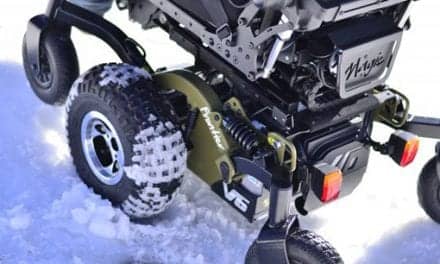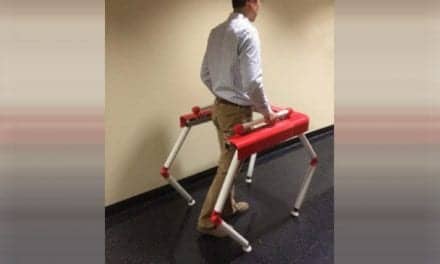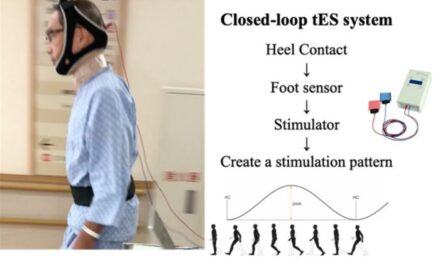
Lauren Snolis, PT, DPT, plays a game with Gabriel Dobbs to help him practice using a power wheelchair. Patients can control their power wheelchairs using a joystick, head array, or integrated control system.
by Lauren A. Snolis, PT, DPT
Wheeled pediatric mobility technology works best when the device is used correctly and consistently. Matching mobility technologies to child and caregiver needs—as well as the child’s level of function, positioning needs, environment and cognitive level—allows for more child functionality and independence, as well as a reduced risk of device abandonment.
For optimal use of the mobility technology, the child and caregiver need adequate training and support to increase skill and comfort levels. Training includes instruction on configuring, adjusting, programming, device options and accessories, as well as the importance of the device in improving the engagement level for a child.
Device Training for Optimal Use
The major purpose of mobility equipment is to allow children to gain independence and explore their environment. In order for optimal device use, the patient and caregiver need training on the benefits of the device, how to care for the device, and how to use the device. Training relies on demonstration and practice, allowing the patient and caregiver to get comfortable with mobility equipment.
Each mobility device can be programmed and modified to fit the client’s needs and abilities. During training, further modifications can be made to optimize mobility and independence. As the child improves through practice, the device can be modified further to match the child’s increased competence.
Manual and Power Wheelchairs
When determining the best wheelchair for a child, therapists look at the child’s level of control and function to determine the optimal way for the child to drive the chair and to program the device.
Wheelchairs can be modified based on the user’s needs, which often requires trial-and-error with a few different options to see what makes the user most successful. If using a manual wheelchair, the therapist will determine the individual’s positioning needs for pressure relief and increased alertness, as well as any additional needs, such as extra storage for users who are on oxygen and need storage for transport.
With power wheelchairs, the therapist and user should discuss options such as power tilt, recline, and the variety of control types that would work best for the user. If using a control type such as a joystick, head array, or integrated control system, therapists can create games or obstacles to help users practice using the device and controls, as well as understand cause/effect, stop/go, and directional concepts. Explaining and practicing these concepts ensures the user knows that an action results in movement, with certain actions resulting in moving the wheelchair in a corresponding direction or stopping the device.
Training the child for manual and power wheelchairs allows the child to practice self-propelling the manual wheelchair or driving the powered wheelchair. Once the ordered piece of equipment arrives, therapists educate the parents on caring for the device, as well as demonstrate how to break down a manual wheelchair. When discussing wheelchairs with users and caregivers, it’s important to discuss transportation of the device. For example, power wheelchairs are heavy and don’t break down, so a vehicle that includes a ramp to drive the chair in or a lift to lift the chair up is necessary for transportation of powered wheelchairs.
Standing Systems
Standing frames are manufactured in a variety of styles, ranging from static to dynamic, but because standers place children in upright positions, training is often needed for caregivers in transferring and positioning of the child.
Therapists will take measurements and adjust the stander to fit the child. Depending on the child’s needs, modifications can be incorporated into standing systems, such as allowing the legs to be set farther apart in hip abduction for deeper placement in the hip joint socket.
Since standers typically stay at the user’s place of residence, therapists will often focus training caregivers on transfers into the stander and positioning for proper support. A lot of children will start in either the sitting or supine position, and then will be raised to standing. Therapists can demonstrate how caregivers should transfer the child in and out of the stander, raising and lowering the stander into the standing position, as well as the use of the belts and straps for positioning to ensure the child is supported properly and in neutral alignment.
Muscle stretch typically happens when in a stander, so tolerance can sometimes be an issue for children. Because of this, therapists should help caregivers understand why it’s important for the child to use the device. Practicing with the device allows the child to build up a tolerance level over time, often starting with being in the stander for 5 to 10 minutes before increasing the time amount.
Strollers
When preparing the stroller for the child, the therapist will determine which support the child needs for sitting and caregiver needs. Training required for strollers is similar to wheelchair training, except the child does not need to learn how to self-propel, as the device is a dependent form of mobility. Instead, caregivers are trained in transferring the child to and from the stroller, as well as maneuvering the stroller.
Caregivers should also be trained in additional stroller positioning features, such as head supports, canopy sun shades, or footrest supports. Since strollers are typically heavy and bulky, therapists should demonstrate how to fold up the device for transport and storage.
Gait Trainers
The goal for gait trainers is for a child to be able to move independently with a gait trainer, but there are benefits of practicing gait even if a child does not become functionally independent, such as improved strength, coordination, motor control, and endurance.
If a child needs a gait trainer, therapists will try a few different trainer types to determine which device is best for the child’s needs. Trainers vary based on design and the supports they offer, with some therapists offering to loan demo gait trainers for the child to try at home. This allows for extra practice with the device, allowing the child to get better at walking independently.
Therapists might start the child in a trainer that is very supportive, but as the child gets stronger and can control their movements more, therapists can decrease the amount of support needed. Therapists should train caregivers on transferring the child in and out of the device and how to secure the child in place. If additional supports are added, such as seat adjustments, chest supports, handlebars, or forearm supports, the therapist will also explain the use and details for ensuring the child is placed in the correct position.
Some children will keep the gait trainer at home, at school, or will transfer the device back and forth. How supportive the trainer is will determine how much the device breaks down for transport. If breakdown of the device is needed, therapists will practice this process with the caregiver to ensure successful transportation.
Multi-Disciplinary Approach and Support for Training
A coordinated, multi-disciplinary approach is essential when working to find the best mobility device for the patient and the family that will prevent device abandonment. This team approach requires working with occupational therapists, physicians, the child’s family, and the child in order to set goals that help the child become as functional and independent as possible. It’s also valuable to work with the equipment vendor when choosing and ordering a device, as these vendors are knowledgeable about different equipment brands and the options each brand offers.
Depending on the situation surrounding the need for a wheeled pediatric device, some parents undergo an emotional process when the child suddenly needs equipment. If therapists can show caregivers the device will allow for more independence and functionality, caregivers typically have an easier time adapting to the change.
Minimizing Device Abandonment
Mobility technologies and proper training can help children with complex disabilities thrive through increased mobility, healing, and independence. For optimal benefits, the child needs to use the mobility technology correctly and consistently. Without proper training in the care, use, and importance of the device, many patients will abandon using their mobility technology.
Reasons for device abandonment can include difficulty in using or maneuvering the device, caregiver trouble with getting the patient in and out of the device, or time restraints for busy families. Lack of consideration of the patient’s opinion in selection or change in user needs are also reasons for device abandonment. Therapists should emphasize child and caregiver involvement throughout the decision-making process, as well as long-term needs of the child, to reduce device abandonment and enhance the satisfaction of the device.
If the device works for the family’s lifestyle and the family sees how the device benefits the child, this allows for device buy-in and will increase the chance the family will use the device. To minimize device abandonment, understand the family’s goals and needs when choosing the most appropriate device. Therapists should also explain why using the device is important, whether it’s for mobility, exercise, or strengthening.
If possible, loaning demos of the equipment to the family to try before ordering the device can prevent device abandonment. With all mobility technology, trial-and-error will determine what works best for the child’s needs. Therapists often try to incorporate for growth as much as possible when ordering equipment to allow the device to be used for a longer period of time. Oftentimes, the device can be brought back to the hospital to be adjusted for better fit, or the caregiver can call the equipment company to make a house visit for device adjustments.
If caregivers have limited training time at the hospital, therapists can provide visual handouts that outline the important features and processes for the device. This is a great resource for future reference if the caregiver needs a quick tutorial on device management and use.
Wheeled mobility technology works best when the user and caregiver have proper training, including demonstrations and practice for increased comfort and skill. If the device matches the needs of the child and family, the device is likely to increase mobility, functionality, and independence through proper use and care of mobility technology. RM
Lauren A. Snolis, PT, DPT, received her Doctor of Physical Therapy degree from the University of Oklahoma Health Sciences Center in 2015. She has been employed at The Children’s Center Rehabilitation Hospital in Bethany, OK, for 1.5 years, where she currently is a physical therapist in the Outpatient Therapy Clinic. For more information, contact [email protected].




